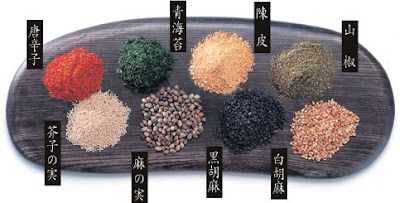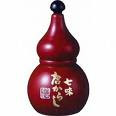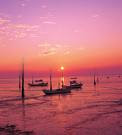::::::::::::::::::::::::::::::::::::::::::::::::::::::::::::::::::::::::::::::::::::::::::::::::::::
Red pepper (toogarashi)
***** Location: Japan
***** Season: see below
***** Category: Plant
*****************************
Explanation

kigo for all autumn
toogarashi 唐辛子 (とうがらし) red pepper, hot pepper
Capsicum annuum, roter Pfeffer, dried chili pepper
..... 唐辛(とうがらし)、..... 蕃椒(とうがらし)
nanban 南蛮(なんばん)、nanban koshoo 南蛮胡椒(なんばんこしょう)
pepper from the "Southern Barbarians" (the first Europeans coming in via Nagasaki around 1605)
koorai koshoo 高麗胡椒(こうらいこしょう)pepper from Koorai-Korea
tenjumori 天井守(てんじょうもり)kind of red pepper
tenjiku mori 天竺まもり(てんじくまもり)
sagari さがり
This is a kind with a straight stem and many fruits on it like a tussle, so it is also called "yatsubusa" 八房(やつぶさ)"with eight tussles".
. . . CLICK here for Photos !
taka no tsume 鷹の爪(たかのつめ)red pepper "like the claw of a hawk"
Evodiopanax innovans
. . . CLICK here for Photos !
..... Fushimi toogarashi 伏見唐辛子 Kyoto speciality from the Fushimi area
. . . CLICK here for Photos !
..... Manganji toogarashi 万願寺唐辛子 Kyoto speciality from temple Manganji
. . . CLICK here for Photos !
and from these areas in Kyoto Tanaka 田中. Yamashina 山科. Takagamine 鷹ヶ峰
Shichimiya Honpo 七味家本舗(しちみやほんぽ), since 1655 is a dealer in Kyoto, close to the temple Kiyomizudera.
:::::::::::::::::::::::::::::::::::::::::::::::::::::::::::::::::::::::::::::::::::::::::::::::::::::

piiman ピーマン green sweet pepper, pimiento, pimento
Capsicum annuum L. var. angulosum, bell pepper
The large variety is called
janboo piiman ジャンボピーマン jumbo green pepper
karaa piiman カラーピーマ colorful bellpeppers
The green variety is usually harvested when still unripe and becomes a red, yellow, purple or orange variety.
Green bell pepper is very rich in vitamin C.
It has been eaten in Japan since the 1950s.
Grown in Miyazaki prefecture.
It is eaten in salads, grilled on a net, fried in the pan with other vegetables, put in soup, cut small for fried rice, put in vinegar for pickles. Western style as ラタトゥイユ Ratatouille or ピペラード piperade.
Paprika
Hasaki piiman 波崎ピーマン from Hasaki town
This town 波崎町 in Ibaraki grows the most piiman in Japan.

Shimajiri piiman 具志頭ピーマン - from Shimajiri town, Okinawa
Yaese piiman 八重瀬ピーマン - from Yaese town, Okinawa
PIMENTO MORI !
:::::::::::::::::::::::::::::::::::::::::::::::::::::::::::::::::::::::::::::::::::::::::::::::::::::

..... shishitoo, shishito ししとう / 獅子唐
small sweet green pepper
Spanischer Pfeffer; Capsicum annuum var. angulosum.
They are often serves on skewers, slightyl grilled and salted, at a yakitoria restaurant.
There are various varieties cultivated during the Edo period. Since the end of this pepper reminded the Japanese of the head of a lion mask, it got this name "lion dans mask pepper".
. . . CLICK here for Photos !
There are also plants with five different colors on one
goshiki toogarashi 五色唐辛子
They are used as decorative garden plants.
. . . CLICK here for Photos !
:::::::::::::::::::::::::::::::::::::::::::::::::::::::::::::::::::::::::::::::::::::::::::::::::::
kigo for mid-autumn
ha toogarashi 葉唐辛子 (はとうがらし)
leaves of the red pepper
They are used for tsukudani boiling with sweet soy sauce.
You can make it yourself or by a bottle in the supermarket.
. . . CLICK here for Photos !
kigo for mid-summer
toogarashi no hana 唐辛子の花 (とうがらしのはな)
flowers/blossoms of the red pepper
..... 蕃椒の花(とうがらしのはな)
They are small and white.
. . . CLICK here for Photos !
kigo for late summer
aotoogarashi, ao toogarashi 青唐辛子 (あおとうがらし) green fruit of the red pepper
..... 青蕃椒(あおとうがらし)
ha toogarashi 葉唐辛(はとうがらし) red pepper leaves
:::::::::::::::::::::::::::::::::::::::::::::::::::::::::::::::::::::::::::::::::::::::::::::::::::::
:::::::::::::::::::::::::::::::::::::::::::::::::::::::::::::::::::::::::::::::::::::::::::::::::::::
The following are NOT KIGO.

© PHOTO : shobo-an
shichimi toogarashi しちみとうがらし【七味唐辛子】
shichimi togarashi, nanami toogarashi, nanami togarashi
"seven flavors and red pepper"
seven flavor chili pepper
ground mix of red pepper and other aromatic spices
pepper blend with seven spices, spice mixture with seven ingredients
Also named Yagenbori 薬研堀 / やげん堀 after a canal street where the first dealers in Edo lived.
The most commonly mixed spices are in the colors of a rainbow, and you can ask a specialized shop to have your own mixture
asa no mi あさのみ【麻の実】 hemp seed (gray, grey)
aonori あおのり【青海苔】 green seaweed (green)
keshi no mi けしのみ【芥子の実】poppy seed (beige)
kuro koshoo くろこしょう【黒胡椒】black pepper (black)
sanshoo さんしょう【山椒】mountain pepper (moss green)
shiro koshoo しろこしょう【白胡椒】white pepper (beige)
shooga しょうが【生姜】ginger
fresh red pepper (orange)
unshuu mikan うんしゅうみかん【温州蜜柑】 mandarin orange peel (yellow)
rapeseed
roasted red pepper (brown)
kuro goma くろごま【黒胡麻】black sesame seed (black)
shiso しそ【紫蘇】 perilla
yuzu ゆず【柚/柚子】yuzu citron peel (from Citrus junos)
It is used in soups, for noodles and many other dishes.
 You can buy it in a hyootan gourd-shaped container like this one.
You can buy it in a hyootan gourd-shaped container like this one.Or in a glass bottle like other spices. Some come in a bamboo container or in a little barrel (taru).
Sieben-Gewürz-Pulver, Sieben-Gewürz-Mischung
shichimi toogarashi mentaiko 七味唐辛子明太子
fish roe with red pepper spice mixture
. . . CLICK here for Photos !
hachimi toogarashi 八味とうがらし, 八味唐辛子
hot pepper mix with eight ingredients
. . . CLICK here for Photos !
ichimi toogarashi 一味唐辛子 ground red chili pepper
"only one flavor"
. . . CLICK here for Photos !
. nanairo toogarashi 七色唐辛子
chili pepper with seven colors .
One of them is orange from the peels of Fukure Mikan ふくれみかん / 福来(ふくれ)みかん
. . . CLICK here for Photos !
speciality of the Mount Tsukuba area 筑波山, Ibaraki
:::::::::::::::::::::::::::::::::::::::::::::::::::::::::::::::::::::::::::::::::::::::::::::::::::::
Yagenbori 薬研堀 "Yagen Canal" in Edo
 Yagen is a chemist's or doctor's mortar form which is like a V, deep and small, to crush medicine. The canals in Edo were often in this form.
Yagen is a chemist's or doctor's mortar form which is like a V, deep and small, to crush medicine. The canals in Edo were often in this form.Yagen Shichimi Togarashi
Yagenbori in Edo is in Asakusa, an old center of entertainment.
A medicine dealer of the area (Yagenbori Shichimi Togarashi), more than 400 years ago, began to mix these ingredients to serve as condiments to go with noodles and other Edo food. It can be mixed to be very hot, medium or rather mild.
Reference

Yagen red pepper containers
. Doctors in Edo .
Many doctors lived at a moat named after the mortar to prepare medicine, called Yagenbori 薬研堀 in Edo.
東京都中央区東日本橋 Now in Higashi Nihonbashi, Chuo ward

Some of their homes had various exits for the patient to come and go unnoticed.
おろすこともっとも至極薬研堀
orosu koto mottomo shigoku Yagenbori
abortion
is most extremely done
at Yagenbori moat
.......................................................................
Yagenbori Fudo Myo-O 薬研堀不動明王
Gofunai Henro Temple Nr. 23
. Gofunai 御府内八十八ヶ所霊場 88 Henro Temples in Edo .
Nr. 23 - 薬研堀不動院 Yagenbori Fudo-In
- 川崎大師東京別院 Kawasaki Daishi Tokyo Betsu-In
中央区東日本橋2-6-8 / 2 Chome-6-8 Higashinihonbashi, Chūō ward
:::::::::::::::::::::::::::::::::::::::::::::::::::::::::::::::::::::::::::::::::::::::::::::::::::::
Tochigi Santaka 栃木三鷹 "three hawk talons" from Tochigi
. . . CLICK here for Photos !
From Otawara village 大田原
 It is harvested by pulling out including the roots, then hang with the roots to dry under a plastic roof for two months. Next each talon is picked by hand, one picker woman can do about five kilos a day. The local shops make different kinds of food from this chilies.
It is harvested by pulling out including the roots, then hang with the roots to dry under a plastic roof for two months. Next each talon is picked by hand, one picker woman can do about five kilos a day. The local shops make different kinds of food from this chilies.toogarashi raamen 唐辛子ラーメン chillies noodle soup
chillies are added to the dough for the noodles too, so they look rather red.

ebichiri toogarashi pan エビチリとうがらしパン bread with a filling of shrimps in hot sauce
the dough for the bread includes chillies too.
choppiri チョッピリ chocolate with red hot peppers
choppiri yookan チョッピリ羊羹 yookan paste with red peppers
also sold in a set with five flavors of yookan bean paste like blueberry and green tea, salty and yuzu citrons.
(orijinaru hitokuchi yookan オリジナル一口ようかん) in memory of the brave archer warrior
Nasu no Yooichi 那須与一 (Nasu no Yoichi)
Nasu no Yoichi (1169 - 1232)
*****************************
Things found on the way
Daruma Mascot and Hot Pepper Miyuki Chan
Hot Pepper だるま マクコット

:::::::::::::::::::::::::::::::::::::::::::::::::::::::::::::::::::::::::::::::::::::::::::::::::::::
The TOO 唐 in Toogarashi refers to Tang-China,
but can also simply mean any foreigner in Japan during the Edo period.
:::::::::::::::::::::::::::::::::::::::::::::::::::::::::::::::::::::::::::::::::::::::::::::::::::::
. tsurushibina つるし雛 / 吊るし雛 small hanging hina dolls .

Red Pepper to ward off insects to chew on the hina dolls when they are packed away during the rest of the year. Also with the wish that no "bad insects" (male friends) will hang around and harm the little girl as it grows up.
They should ward off evil influence of all kinds.
*****************************
HAIKU and SENRYU
赤とんぼ羽を取ったらとうがらし
akatonboo hane o tottara toogarashi
red dragonfly -
when you take the wings off
it is just a red pepper
Takarai Kikaku ・【宝井基角】(たからい・きかく)
With a reply from Matsuo Basho
Dragonfly and Haiku
.............................................................................

青くても 有るべきものを 唐辛子
aokute mo aru beki mono o toogarashi
green was just right
and yet now it's
a red pepper
Tr. Barnhill
better
to have stayed green -
the pepper
Tr. Addiss
Written in 1692. 元禄5年9月
At a meeting with his disciple Shadoo 洒堂 Shado coming to Edo to visit his Basho-An in Fukagawa. He wanted to praise his student, but still ...
. Matsuo Basho 松尾芭蕉 - Archives of the WKD .
with more toogarashi haiku
. Shadoo 洒堂 Shado - - Hamada Chinseki 浜田珍夕/珍碩 .
:::::::::::::::::::::::::::::::::::::::::::::::::::::::::::::::::::::::::::::::::::::::::::::::::::::
炎ゆる間がいのち女と唐辛子
moyuru ma ga inochi onna to toogarashi
burning red hot
when alive ... a woman
and red pepper
Mitsuhashi Takajo 三橋鷹女
:::::::::::::::::::::::::::::::::::::::::::::::::::::::::::::::::::::::::::::::::::::::::::::::::::::
cayenne
long fingers of heat
reaching into winter
a lot of people used to hand these in bunches to dry for use in the winter when a little bit of heat in the food helps warm the insides.
Brenda Roberts
. WKD ... on FACEBOOK . June 2009
::::::::::::::::::::::::::::::::::::::::::::::::::::::::::::::::::::::::::::::::::::::::::::::::::::
red hot pepper -
another fight over
Indian curry
Gabi Greve
my husband likes it REALY HOT !
*****************************
Related words
Mountain pepper (sanshoo, sansho) Japan
***** WASHOKU :
YASAI . Vegetable SAIJIKI
:::::::::::::::::::::::::::::::::::::::::::::::::::::::::::::::::::::::::::::::::::::::::::::::::::::::::::::::::::::::::::
[ . BACK to DARUMA MUSEUM TOP . ]
[ . BACK to WORLDKIGO . TOP . ]
- #togarashi #redpepper #yagenbori -
:::::::::::::::::::::::::::::::::::::::::::::::::::::::::::::::::::::::::::::::::::::::::::::::::::::::::::::::::::::::::::


















